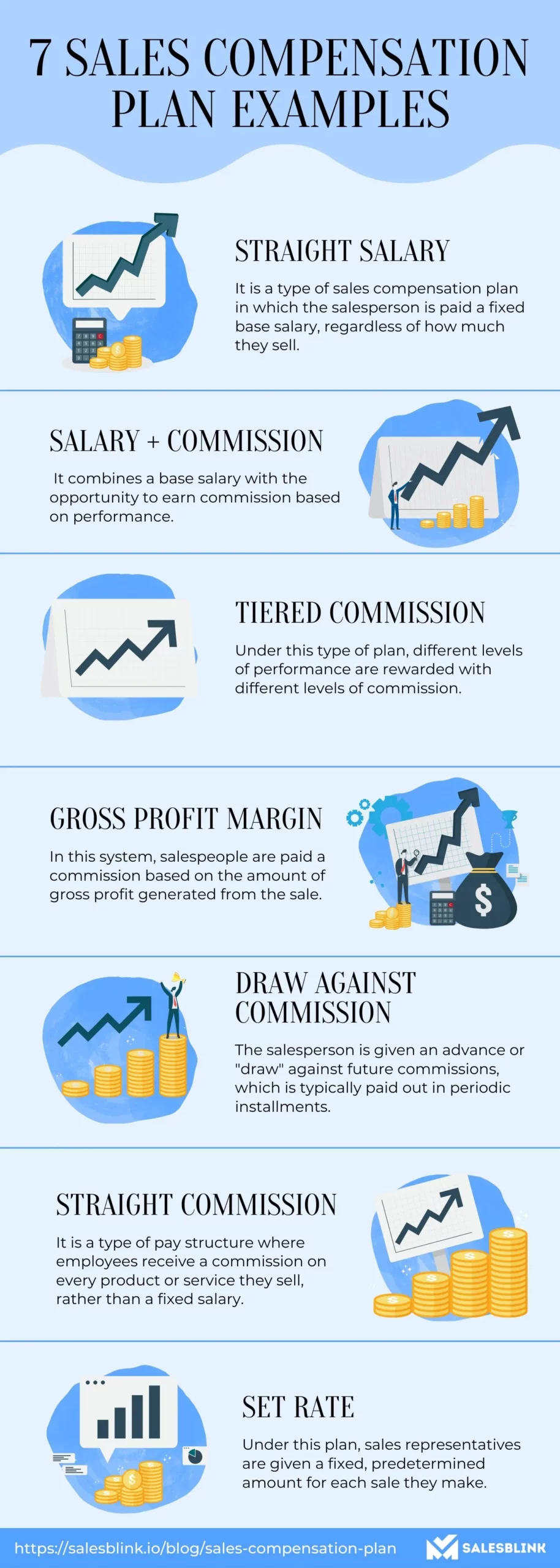7 Sales Compensation Plan Examples To Motivate Your Team
Are you aware that happy employees are 12% more productive and unhappy ones are 10% less? As a business owner, it’s therefore clear that you have to keep your team motivated and happy. One way to do this is to offer a sales compensation plan to incentivize them to reach their goals. If you need to learn how to begin, you are at the right place.
In this post, we’ll take a closer look at sales compensation plans that you can use for your organization with their benefits and steps to create them with the best practices to follow.
So without any further ado, let’s get started.
Table Of Contents
What Are Sales Compensation Plans?
A sales compensation plan is a structured plan that determines how much reps earn on the basis of their performance.
They are approaches that companies use to incentivize their sales teams to perform at their highest potential. In addition, these plans help to motivate sales reps and give them the incentive to reach and exceed their goals.
Sales compensation plans come in many forms, from bonus-based to commission-based plans.
Bonus-based plans may involve rewards such as cash bonuses or gift cards, while commission-based plans typically involve a percentage of sales paid to the representative.
No matter the type of plan, you should tailor it to the needs of the organization and its sales team. It is essential to consider how the sales compensation plan will impact the motivation and performance of the sales team and the overall bottom line.
Additionally, it is essential to ensure that the plan is fair and equitable among the sales team. By providing an effective compensation plan, companies can ensure that their sales team has the motivation and incentive to reach their goals.
Benefits Of A Sales Compensation Plan
Any business that relies on sales to grow and succeed must have a compensation plan in place. A well-crafted plan helps to motivate sales teams and promote sales performance. The benefits of a sales compensation plan include:
1. Increased sales

A well-structured bonus plan gives sales teams clear objectives and goals to work towards, motivating them to sell more. Bonuses help to incentivize sales teams further and encourage them to go beyond their normal efforts.
2. Improved efficiency

By clearly outlining the terms of a sales compensation plan, organizations can reduce time spent negotiating and providing one-off solutions. In addition, a clear system helps to align sales goals with the company’s overall objectives, which helps to streamline the sales process.
3. Reduced attrition rate and better talent retention

Sales reps that feel adequately rewarded for their efforts are less likely to leave the company. A solid compensation plan helps ensure sales reps are motivated and rewarded for their contributions. This would help you retain your company’s top talent and expedite the business’s growth.
4. Improved employee morale

Providing sales reps with a sense of ownership and autonomy over their job can help increase job satisfaction and morale. In addition, sales reps that feel valued for their contributions are more likely to stay with the company and be more productive. This is crucial for the success of the company.
Overall, a sales compensation plan can provide several benefits to any business that relies on sales. It helps to motivate sales teams, improve efficiency, and do much more. Utilizing a well-crafted compensation plan helps ensure that the sales team is motivated and produces positive results.
How To Create A Sales Compensation Plan?
Here’s how you can create a sales compensation plan,
Step 1: Understand what a Good Sales Compensation Plan requires
A good sales compensation plan requires careful planning and consideration of various factors. Try to tailor it to the company, the industry, and the specific sales team. In addition, you should align it with the company’s overall business goals and focus on rewarding performance over activities.
The plan’s elements – pay, incentives, recognition, job design, and career development – should be structured to motivate salespeople to become more productive and successful. It should also be easy to communicate and understand, and you should keep it up to date with any changes in the market, the competition, and the company.
Furthermore, a good sales compensation plan should have measurable goals specific to each role within the sales team. A fair plan for all parties is essential so that everyone gets adequate incentives and there are no potential conflicts of interest. Proper documentation will also ensure that everyone is held accountable for their performance. With the right plan in place, sales teams can be more motivated and successful in achieving their goals.
Step 2: Establish Role Levels
Establishing role levels in a sales compensation plan is essential for several reasons. First, it defines expectations for sales personnel, providing clarity for individuals and teams. Role levels provide a way to measure performance and determine if individuals or teams are meeting expectations. They also offer an objective way to compare performance across different roles.
Furthermore, you can use role levels to incentivize employees, rewarding them for their achievements. Establishing role levels can also help ensure that teams are properly balanced and that each team member has their focus on the products or services they’re responsible for selling.
Additionally, role levels ensure managers can appropriately assign tasks and responsibilities to ensure maximum efficiency and productivity. Finally, role levels can help ensure that reps get proper compensation for their efforts and that their compensation syncs with their performance and results. By establishing clear role levels, businesses can ensure that their sales compensation plans are both fair and effective.
Step 3: Determine Total On-Target Earnings (OTE)
When creating a sales compensation plan, it is essential to determine the total on-target earnings for each salesperson.
OTE or on-target earnings refers to the total compensation a sales rep will get when they can meet what is expected of their role successfully.
The total on-target earnings are calculated by taking the base salary and adding additional incentives or bonuses that are part of the sales compensation plan. These can include commissions, spiffs, stock options, and other rewards. The total on-target earnings should account for all of the additional rewards provided and ensure that the total is appropriate for the desired level of performance and the current market conditions. To determine the total on-target earnings, it is essential to consider the salesperson’s experience, performance, and the size of the company’s sales force and customer base. This way, the on-target earnings are competitive and accurately reflect the goals and objectives in the sales compensation plan.
Step 4: Fix Base Pay and Sales Commission Structure
A base pay and sales commission structure rewards sales representatives for their efforts and encourages them to generate more sales. The base salary compensates them for the time and effort they invest in the job, and the additional commission incentivizes them to do their best for the company.
The commission structure is typically tiered, with higher percentages for larger sales. This ensures that sales reps are rewarded for their effort and are motivated to strive for bigger sales. A sales commission structure should also include incentives for exceeding quotas and recognition for meeting sales goals. This encourages sales reps to strive for better results continually and helps motivate them to reach their goals.
The success of a fixed base pay and sales commission structure depends on how the organization implements it. Therefore, it is important to set realistic quotas and incentives and provide feedback to sales reps on their performance. This will help ensure that the plan is effective and that sales reps perform their best. Additionally, periodic performance evaluations are necessary to ensure the plan is successful and that sales reps meet their goals.
Step 5: Set Targets
When it comes to creating a successful sales compensation plan, setting sales targets is an essential component. Targets motivate sales teams and give them something to strive for to maximize their earnings potential. The sales targets should be realistic and achievable and tailored to the individual salesperson, taking into account their experience, skills, and performance.
Try to align them with the company’s goals, objectives, industry standards, and market conditions. Then, review them regularly to ensure that they are still relevant and achievable. It is also important to consider incentives such as bonuses and commissions that you can use to reward top performers and encourage the whole team to strive for more.
You should provide sales teams with clear feedback on their progress towards the target. This should include detailed information such as the number of sales made, the number of leads, and the average sale value. This helps the sales team to see how they are doing and can be used to identify areas where they can improve. Finally, you should monitor and evaluate the target to ensure it is still relevant and achievable.
Sales Compensation Plans
Here are the top 7 sales compensation plan examples to better help you understand the concept.

1. Straight salary
The Straight salary sales compensation plan is a type of sales compensation plan in which the salesperson receives a fixed base salary, regardless of how much they sell. This type of plan does not incentivize the employee to sell more, which can lead to a decrease in overall sales. Additionally, it can be challenging to compare the performance of different employees when everyone gets the same salary. This plan is rare in companies focusing on sales as it doesn’t differentiate a person closing 10 sales from one closing just 1.
2. Salary + commission
The salary + commission plan is a popular form of compensation for salespeople. It combines a base salary with the opportunity to earn a commission based on performance. The base salary provides the employee with a guaranteed income, and the commission provides an additional incentive for the employee to exceed their goals. This type of plan is attractive to employers because it allows them to reward employees for high performance without committing to a large salary.
It also works well for employees because they have the potential to make more money as they reach higher levels of performance. In this type of plan, the commission rate is typically a percentage of sales or profits and can vary depending on the employee’s performance.
3. Tiered commission
The Tiered Commission plan is an incentive program to reward salespeople for their performance. Under this type of plan, different levels of performance attract rewards as different levels of commission.
For example, a seller who meets a certain level of sales might get a 10% commission, while a seller who exceeds that level might get a 15% commission. This type of plan finds its use in highly competitive sales environments where salespeople must work hard to meet challenging goals. The goal is to motivate salespeople to strive for higher performance levels while ensuring they get compensation for their efforts.
4. Gross profit margin
The Gross Profit Margin Sales Compensation Plan is an incentive program many companies use to reward their sales teams for their efforts. This type of plan rewards salespeople based on the gross profit margin (GPM) of their sales. In this system, salespeople receive a commission based on the gross profit generated from the sale. This type of compensation plan aims to motivate salespeople to focus on larger and more profitable sales, as their commission is based on the profits generated rather than the sales volume.
5. Draw against commission
The draw-against-commission sales compensation plan is a type of incentive plan designed to reward sales professionals for their performance. The salesperson is given an advance or “draw” against future commissions, which the company typically pays out in periodic installments. The draw is then subtracted from any commissions the salesperson earns, meaning that they must reach certain targets to receive the full amount of their draw. This type of incentive plan can benefit both employers and employees, as it allows for a steady income for the salesperson while also helping employers control their costs. Draw against commission plans can also be flexible, allowing employers to adjust the draw amount based on the salesperson’s performance.
6. Straight commission
The Straight commission sales compensation plan is a type of pay structure where employees receive a commission on every product or service they sell rather than a fixed salary. This type of plan is common in industries where salespeople have to work independently, such as real estate or insurance. It is often seen as an attractive proposition for salespeople, giving them a chance to increase their earnings significantly if they successfully make sales.
However, it also puts a great deal of pressure on them to perform or else risk not getting paid. This can create an incentive for salespeople to take on more risks to maximize their earnings, which can have positive and negative consequences for a business.
7. Set rate
The Set Rate Sales Compensation Plan is a strategy businesses use to incentivize their sales staff. Under this plan, sales representatives are given a fixed, predetermined amount for each sale they make. The amount may vary depending on the product or service in concern, or it may be the same regardless of the sale.
This plan is beneficial for both employers and employees as it allows employers to budget more accurately and employees to know exactly how much they’ll get for each sale. It also encourages sales reps to focus on closing deals instead of worrying about commission rates. However, the plan has its drawbacks, as it does not incentivize sales reps to upsell or provide additional services.
How To Choose The Right Sales Compensation Plan For Your Company?
Choosing the right sales compensation plan for your company can be difficult. There are various factors to consider when making this decision, from the size and structure of your organization to the type of sales positions and the goals you want to achieve. It is important to ensure that your sales compensation plan promotes the desired behaviors and results among your sales team. To choose the right plan, consider the following:
1. What type of sales team do you have? Are you looking to reward individual performance or team-based performance?
2. What incentives will motivate your sales team? Will a commission-based plan motivate them to reach their goals, or do they need a bonus structure to incentivize them?
3. How will the compensation plan be structured? Consider the complexity of the plan and how it will track and reward performance.
4. What are your company’s financial goals? Consider the impact of the plan on both short-term and long-term financial stability.
By considering these factors, you can create a sales compensation plan tailored to your company’s needs and help motivate your sales team and reach your financial goals.
Must-Know Sales Compensation Terms
There are a few commonly used terms in sales compensation, and you must know about them. So here are some of them for your help.
1. Sales Quota
A sales quota is a target or goal set for a sales professional or an entire team. It is typically assigned on a quarterly or annual basis and based on the projected sales of a product or service or the desired market share the company aims to achieve.
Sales quotas are often set by a team, department manager, or the company’s executive leadership. Achieving one’s sales quotas is often a significant part of the motivation and compensation packages for a salesperson or team.
Sales quotas are based on a number of factors, such as the size of the market and the expected demand for a product or service, the competition in the industry, the company’s budget, marketing campaigns, and the salesperson’s or team’s ability to reach prospective customers.
2. Sales Accelerators
Sales accelerators are rewards offered by organizations to motivate and reward salespeople for reaching certain goals. These incentives can include anything from cash bonuses and vacations to gift cards and time off.
By offering incentives, organizations can encourage salespeople to work harder and reach their targets faster.
Sales accelerators can also motivate salespeople to focus on specific areas that are important to the organization’s growth, such as new products or services. You can use sales incentive programs to recognize the best salespeople and reward them accordingly. Incentives can create a sense of competition and foster a more positive work environment, leading to higher sales and more satisfied customers.
3. Sales Decelerators
A sales decelerator is a tactic that involves reducing the commission rate of reps, that brings their earnings down in relation to what they would have made with the base commission rate. The aim is to discourage poor performance if the rep doesn’t achieve the sales quota or reduce high payouts (once the rep hits the quota).
4. Sales Performance Incentive Fund
Sales Performance Incentive Fund (SPIF) is a type of bonus program used by companies to incentivize sales teams to reach performance targets. The SPIF program involves setting goals for sales staff, such as achieving a certain number of sales or reaching a specific level of customer satisfaction. When the goals are met, the company provides financial rewards to the employees through cash bonuses, products, or other incentives.
Sales Compensation Plan Best Practices
It is now time to know about the best practices to follow when building a sales compensation plan.
1. Be realistic with your sales quota

When setting a sales quota, it’s important to be realistic. A good starting point is to look at the previous sales data and establish a real target for the upcoming period. It’s also essential to consider any changes in the market or the competitive landscape that could affect the projected number.
Once you have a target quota, it’s essential to ensure that it is achievable by considering the resources available to your sales team. If the quota is too high, it can be demotivating and lead to burnout. On the other hand, if it’s too low, it can lead to complacency and underperformance. Setting a realistic quota will help ensure that your sales team is motivated to meet their goals and that your sales compensation plan is effective.
2. Keep the incentives attractive enough

It is essential to ensure that the incentives you offer are attractive enough to motivate sales representatives to go above and beyond their regular duties. This could mean offering cash bonuses, additional vacation days, or other rewards that are meaningful to your sales team. Additionally, reviewing your compensation plan periodically is essential to ensure that it is still motivating your team and helping you achieve your business goals. Doing so can ensure that your incentives remain attractive and effective.
3. Avoid capping sales commission

When you cap sales commission, sales reps automatically stop selling once they achieve the target. This can be detrimental to your business as the reps would stop selling actively, leading to missing out on great opportunities. As a result, the sales can witness a stall, and you can avoid that by not capping sales commissions.
4. Answer questions and address the fears of reps

Sales reps often have questions and fears related to sales compensation. Addressing these questions and fears can help build trust and ensure reps are adequately motivated and incentivized.
One common question is how their compensation is determined. Explaining the criteria for calculating commission, bonuses, and other compensation forms can help alleviate any worries or confusion. It’s also essential to let reps know that the organization monitors their performance fairly and objectively.
Another area for sales reps is certainty about how long it will take to get paid. Again, being transparent about payment timelines can help to reduce anxiety and ensure that reps are not waiting too long for their earnings.
Finally, sales reps may be concerned that it is a fair compensation scheme. Assuring them that the scheme is designed to reward outstanding performance and that they will be compensated appropriately can help to ease any fears they have.
5. Appreciate and recognize performance

Appreciating and recognizing sales reps’ hard work and dedication is essential. There are a few different ways to do this. First, it’s important to provide feedback and recognition regularly. This could include giving verbal praise, handing out awards, or offering incentives for reaching certain goals. It’s also a good idea to create an environment where reps feel supported and respected. Try providing mentoring and coaching, encouraging collaboration, or creating a positive and motivating atmosphere. Help reps with sales motivational quotes.
By taking the time to appreciate and recognize the performance of sales reps, you can help boost morale, increase productivity, and create a better working environment for everyone involved. You can also talk about time management for sales reps.
Pick The Most Suitable Sales Compensation Plan For Your Organization
As you have seen, implementing an effective sales compensation model or plan can be an effective way to motivate and reward your sales team. Selecting the right plan for your business can make a world of difference in your team’s performance, so it’s important to find the right plan. With our inputs, you will surely be able to make the right choice and see wonderful results in no time. Once that is in place, you can start seeing better results and make sure your sales team is happy. However, when that happens, don’t forget to thank us!
FAQs
To create an effective sales compensation plan, you must understand what a good plan requires, establish role levels, determine total on-target earnings, fix base pay and sales commission structure, and set targets.
Straight salary, Salary + commission, Tiered commission, Gross profit margin, Draw against commission, Straight commission, Set rate are a few sales compensation plan examples you can implement in your organization.
With a well-structured bonus plan, sales teams have clear objectives and goals to work towards, motivating them to make more sales. Giving bonuses helps incentivize sales teams further and encourages them to do their best.
The most common sales compensation plan of all is the commission-based plan, where salespeople receive a percentage of the sales revenue they generate. It works well for most businesses.
The components of a sales compensation plan typically include a base salary, commission or bonus structure, sales quotas or targets, & performance metrics or key performance indicators (KPIs) that are used to evaluate the salesperson’s performance.







